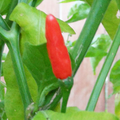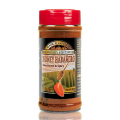7 Pot Jonah Pepper Powder - 1kg (2.2lb) | 7 Pod Jonah
The Trinidad 7 Pot is also called the 7 Pod Jonah. This large pepper offers fruitier flavor than the traditional 7 Pot, as well as a little more heat. The Trinidad 7 Pot ranks between 800,000 and 1,200,000 SHUs. Just for reference, that’s somewhere between 100 and 480 times hotter than the popular Jalapeno. The pepper matures from light green to dark red. The 7 pot pepper has a nice fruity, yet nutty flavor that is similar to the Habanero. The fruity taste gives hints of its Caribbean origins.
7 Pod surfaces contain bumps and lumps and some pods will grow small scorpion tails. These two peppers are related but the 7 Pot’s heat ranks higher than the Ghost Chile. The pepper gets its name because of the rumors surrounding it. It is said, the pepper is so hot that a single pepper provides the heat for seven pots of soup.
History of the Trinidad 7 Pot Pepper
You’ll find the origin of the Trinidad 7 Pot just northeast of Venezuela on the island of Trinidad. However, the chili is not grown commercially in the region, and they can’t be found in the markets there. They are grown in the Chaguanas region of Trinidad. Eventually, the peppers made their way to Asia and Europe during the Columbian Exchange.
How the 7 Pot is Used
The 7 Pod Jonah is great for adding general spice. Add it to stews, soups and many other dishes. A little bit of the Trinidad 7 Pot produces a lot of heat. Remember to add it sparingly, especially until you can build up a tolerance of hotter foods. Use it to make a tasty and hot salsa or hot sauce. Grind dried peppers into a powder so it can easily be added to dishes.
The uses of the Trinidad 7 Pot in Trinidad includes the making military-grade pepper spray and marine paint. It’s use in marine paint serves the purpose of preventing barnacles from growing on boat hulls.
Cultivating Trinidad 7 Pot Chili Peppers
Spring is the best season to start pepper plants. To get the seeds started, place them in moist potting soil. Cover them with about a quarter inch of soil and add water. Do not sow the seeds too deep or they will not be able to break through the surface. The best temperature for seeds to germinate is between 75 and 85 degrees Fahrenheit. Colder temperatures prevent seeds from germinating. In order to speed up the germination process, soak the seeds overnight in water. This softens the seed case for ease of sprouting.
If you plant the seeds in a seed case, it will have a lid. Using the lid helps create a humid environment. Seedlings love humid environments. If you do not have a seed case, plant the seeds in small flower pots and cover them with cellophane. Use a needle to poke a few small holes in the cellophane. Place the planted seeds in a warm, sunny space. Be sure to label the seeds so you won’t forget which seeds were planted.
Seedlings benefit from heat, oxygen and moisture, but mainly, they benefit from light. Purchase a grow light if needed to ensure seeds and plants have adequate light. Once the seedlings form a second set of leaves, then they are ready to transplant. Replant them in larger pots with more soil. You might set them outside for a few hours at a time and let them start to acclimate to the environment.
Once the plants are strong enough, the weather is warmer, and there is no danger of frost, plant them outside. Do not put them directly in the sun. If the plants grow large and hang down, use bamboo sticks for support. If you want to be able to bring the peppers indoors when the weather cools off in the autumn, just plant them in large enough pots to accommodate their growth.
- 7 pot Peppers
No posts found






























